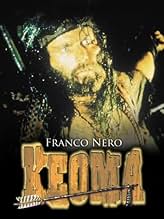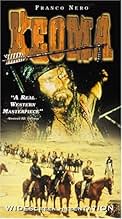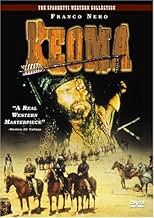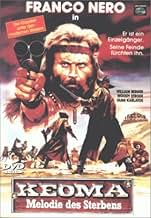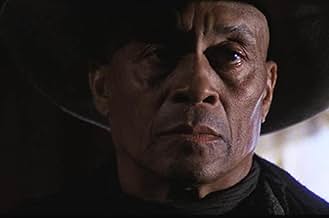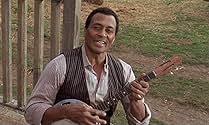IMDb RATING
7.0/10
6.5K
YOUR RATING
An ex-Union gunfighter attempts to protect his plague-ridden hometown from being overridden by his racist half-brothers and a Confederate tyrant.An ex-Union gunfighter attempts to protect his plague-ridden hometown from being overridden by his racist half-brothers and a Confederate tyrant.An ex-Union gunfighter attempts to protect his plague-ridden hometown from being overridden by his racist half-brothers and a Confederate tyrant.
Joshua Sinclair
- Sam Shannon
- (as John Loffredo)
Donald O'Brien
- Caldwell
- (as Donald O'Brian)
Leonardo Scavino
- Doctor
- (as Leon Lenoir)
Antonio Basile
- Caldwell's Henchman
- (uncredited)
Giovanni Bonadonna
- Caldwell's Henchman
- (uncredited)
Armando Bottin
- Caldwell's Henchman
- (uncredited)
Aldo Canti
- Wagon Fugitive
- (uncredited)
- …
Felice Ceciarelli
- Caldwell's Henchman
- (uncredited)
Featured reviews
This film has so much that works so well, it's a shame one thing keeps it from working entirely l: the music. The single most annoying song I've ever heard in a film. Secondly the newest "restored" version inexplicably has two totally different English voices dubbed for Nero. His first few lines are delivered in a deep clear "radio announcer" pure English baritone, the rest of the film is in a poorly faked accent. What exactly would be the reason for this? Other than those two distractions, a great late era entry to the genre.
Talk to most Spaghetti Western fans and they will declare Keoma to be one of the finest of the genre's movies, and probably the best of the latter day ones. However they will also most probably comment on the atrocious soundtrack, which does take some getting used to. I honestly believe that if this movie had been given the Morricone touch, it would be firmly cemented as a true Spaghetti classic, standing side by side with The Big Gundown, Face to Face and Bullet for the General.
Aside from Django, this is Franco Nero's best role. A half breed venger, riding into a town decimated by both the plague and a gang of racist ex-Confederates, which includes his three hateful "brothers" in their ranks. There are also fine turns by William Berger as Keoma's adopted father Shannon, and Woody Strode as Keoma's childhood hero turned drunk, George.
As always, Castellari has injected true class into this film, with slow motion shootouts, effective flashbacks and clever camera tricks. This film is a true fitting end to the Spaghetti hay day, which had begun to loose its charm due to the ever increasing stupidity of the comedy westerns. The only negative aspect is that wretched soundtrack. Oh where was Morricone when we really needed him?
Aside from Django, this is Franco Nero's best role. A half breed venger, riding into a town decimated by both the plague and a gang of racist ex-Confederates, which includes his three hateful "brothers" in their ranks. There are also fine turns by William Berger as Keoma's adopted father Shannon, and Woody Strode as Keoma's childhood hero turned drunk, George.
As always, Castellari has injected true class into this film, with slow motion shootouts, effective flashbacks and clever camera tricks. This film is a true fitting end to the Spaghetti hay day, which had begun to loose its charm due to the ever increasing stupidity of the comedy westerns. The only negative aspect is that wretched soundtrack. Oh where was Morricone when we really needed him?
I have to pretty much agree with the two negative reviews below, and I'll explain why in a minute.
Franco Nero plays "Keoma" a half-breed Indian raised by a white man named Shannon (William Berger) who also has three sons (adoptive brothers of Keoma) who hate him and have never accepted a 'half-breed' as their brother.
There's also George (Woody Strode), an ex-slave and friend of Shannon's who teaches Keoma all he knows about fighting.
Cut 20 years later after some flashbacks and Keoma returns to the town near where he was raised and finds that a plague has engulfed the town with a quarantine imposed by a wealthy mine owner Caldwell (Donald O'Brien) who would just as soon have it's inhabitants all die off so he can fully control the area. Keoma steps in to save a pregnant woman who Caldwell's men suspect as a plague carrier and all hell breaks loose.
Yeah, some of the knife throwing does look ludicrous, but the fist fights look good and there's an excellent gun battle in town between Keoma, Shannon and George vs. Caldwell's men. It's really done well and it looks like it was filmed in the same western set built outside of Rome as DJANGO was ten years earlier. By this time though, the place looks pretty run down and cluttered which makes a good setting for a plague-infested town.
As far as negatives go, the music sucks. It's an annoying high pitch (mostly female) whine that appears periodically throughout the move, inter sprinkled with 'singing' done by Franco Nero himself. It sounds awful as he tries to imitate Leonard Cohen but winds up sounding like a lame Tom Waits. I don't know why anybody likes it. To each his own, I guess.
There's also the annoying Sam Peckinpah-like slow-motion effects that become a cliché used over and over. It ruins some of the great gunfights, especially at the end where Keoma is battling his brothers in a barn while the pregnant lady's screams drown out all the gun battle sound. A little too arty for my tastes.
The dubbing is OK and it sounds like Nero dubbed in his own voice which comes off as strange and foreign for a half-breed American Indian. I suppose one gets used to it as the film goes along.
The Anchor Bay DVD uses an anamorphic widescreen print that looks pretty good. Only a few scratches during the opening and closing titles. No closed captioning. Nero also does a 10 minute interview explaining how the film came about, along with a secondary audio track by director Enzo Castellari giving details about the filming. Yeah the spaghetti western genre was dead by the time this film was made, but Castellari says it did very well in Italy although not enough to revive the genre. Tastes were moving towards gangsters and crime dramas by the mid-70s, so this film was an exception, not the rule.
It has some good ideas but I wouldn't consider it a masterpiece for the genre or anything. However I did enjoy some of the gun play and fistfights.
6 out of 10
-
Franco Nero plays "Keoma" a half-breed Indian raised by a white man named Shannon (William Berger) who also has three sons (adoptive brothers of Keoma) who hate him and have never accepted a 'half-breed' as their brother.
There's also George (Woody Strode), an ex-slave and friend of Shannon's who teaches Keoma all he knows about fighting.
Cut 20 years later after some flashbacks and Keoma returns to the town near where he was raised and finds that a plague has engulfed the town with a quarantine imposed by a wealthy mine owner Caldwell (Donald O'Brien) who would just as soon have it's inhabitants all die off so he can fully control the area. Keoma steps in to save a pregnant woman who Caldwell's men suspect as a plague carrier and all hell breaks loose.
Yeah, some of the knife throwing does look ludicrous, but the fist fights look good and there's an excellent gun battle in town between Keoma, Shannon and George vs. Caldwell's men. It's really done well and it looks like it was filmed in the same western set built outside of Rome as DJANGO was ten years earlier. By this time though, the place looks pretty run down and cluttered which makes a good setting for a plague-infested town.
As far as negatives go, the music sucks. It's an annoying high pitch (mostly female) whine that appears periodically throughout the move, inter sprinkled with 'singing' done by Franco Nero himself. It sounds awful as he tries to imitate Leonard Cohen but winds up sounding like a lame Tom Waits. I don't know why anybody likes it. To each his own, I guess.
There's also the annoying Sam Peckinpah-like slow-motion effects that become a cliché used over and over. It ruins some of the great gunfights, especially at the end where Keoma is battling his brothers in a barn while the pregnant lady's screams drown out all the gun battle sound. A little too arty for my tastes.
The dubbing is OK and it sounds like Nero dubbed in his own voice which comes off as strange and foreign for a half-breed American Indian. I suppose one gets used to it as the film goes along.
The Anchor Bay DVD uses an anamorphic widescreen print that looks pretty good. Only a few scratches during the opening and closing titles. No closed captioning. Nero also does a 10 minute interview explaining how the film came about, along with a secondary audio track by director Enzo Castellari giving details about the filming. Yeah the spaghetti western genre was dead by the time this film was made, but Castellari says it did very well in Italy although not enough to revive the genre. Tastes were moving towards gangsters and crime dramas by the mid-70s, so this film was an exception, not the rule.
It has some good ideas but I wouldn't consider it a masterpiece for the genre or anything. However I did enjoy some of the gun play and fistfights.
6 out of 10
-
A half-breed Indian Keoma returns back to his hometown after fighting in the Civil War, and finds his town is being run by an ex-Confederate soldier Caldwell and his outlaws. He holds power over the town by letting the plague infect the inhabitants, and since he won't let any sort of treatment be transported in. He sets up a community for those infected, and this where Keoma rescues a pregnant woman on her way there and returns her back to town. His three half-brothers have joined Caldwell, and I don't think that highly of their brother's return. But loyalty to their father, they won't kill him. His father William Shannon and former family servant/only friend George eventually join Keoma to break the strangle hold Caldwell possess.
Whoa! How good? Real good. Director Enzo G. Castellari's grand looking and interesting spaghetti western comes across as a powerful and beautifully constructed Greek tragedy with a cynical and almost psychological edge bound to it. There's a bit everything chucked into this passionate and intelligent exercise. Breathing high on mood and atmosphere, photographer Aiace Parolin exquisitely frames the mercilessly brooding locations and Castellari's stylishly first-rate direction keeps the film sombre with a brutally unsparing and dirt-laced tone in its dramatic images and context. Good use of abstract lighting and composition, he knows how to keep the viewer at bay with slam-bang set pieces towards the end and a downbeat undercurrent. Inventive framing and exposition also shows the quality of his direction. The glorious slow-motion shootouts and editing technique (ala Sam Peckinpah) are dazzling and how about the constant jumping or leaping in the air. Was there a hidden trampoline on set?! Everything about it held a nice rhythm to it and you just get swept along. Even the flashback sequences are positioned in the story accordingly and in a fulfilling style. The lyrical story is full of symbolic and thematic issues (freedom being the main focal point) that do pack a punch, but also showing a vulnerable side. This gave it a real singular vibe to set it apart from the crowd. Hell, I didn't mind the uncanny and soaring ballad soundtrack too. The way it actually interlocked with the film's sequences, I thought it gave the film some soul and a backbone (well other than always charismatically reliable Nero). A rugged Franco Nero was outstanding. Both mentally and psychically in his scrappy determination and seldom figure Keoma. The impressively committed Woody Strode was excellent. William Berger brought class, and Olga Karlatos decently balanced out an innocent side that really was moving. Donald O'Brien nails it down in a starch turn as the villainous Caldwell.
Whoa! How good? Real good. Director Enzo G. Castellari's grand looking and interesting spaghetti western comes across as a powerful and beautifully constructed Greek tragedy with a cynical and almost psychological edge bound to it. There's a bit everything chucked into this passionate and intelligent exercise. Breathing high on mood and atmosphere, photographer Aiace Parolin exquisitely frames the mercilessly brooding locations and Castellari's stylishly first-rate direction keeps the film sombre with a brutally unsparing and dirt-laced tone in its dramatic images and context. Good use of abstract lighting and composition, he knows how to keep the viewer at bay with slam-bang set pieces towards the end and a downbeat undercurrent. Inventive framing and exposition also shows the quality of his direction. The glorious slow-motion shootouts and editing technique (ala Sam Peckinpah) are dazzling and how about the constant jumping or leaping in the air. Was there a hidden trampoline on set?! Everything about it held a nice rhythm to it and you just get swept along. Even the flashback sequences are positioned in the story accordingly and in a fulfilling style. The lyrical story is full of symbolic and thematic issues (freedom being the main focal point) that do pack a punch, but also showing a vulnerable side. This gave it a real singular vibe to set it apart from the crowd. Hell, I didn't mind the uncanny and soaring ballad soundtrack too. The way it actually interlocked with the film's sequences, I thought it gave the film some soul and a backbone (well other than always charismatically reliable Nero). A rugged Franco Nero was outstanding. Both mentally and psychically in his scrappy determination and seldom figure Keoma. The impressively committed Woody Strode was excellent. William Berger brought class, and Olga Karlatos decently balanced out an innocent side that really was moving. Donald O'Brien nails it down in a starch turn as the villainous Caldwell.
A mestizo ex-soldier named Keoma (Franco Nero's long hair is a wig) helps a pregnant woman (Olga Karlatos) from cutthroats. Keoma (the word/name Keoma means freedom) returns to a small town after the Civil War . The ghastly village is ruled by violent outlaw gangs (led by Donald O'Brien), along with Keoma's three brother . Half-breed Keoma is helped by an alcoholic old man (Woody Strode) and his adoptive father (William Berger). The bandits leader prohibits the inhabitants leave from damned little town besieged by pest .
This twilight spaghetti Western packs a decrepit aesthetic, racist denounce and innovating scenarios set in Elios studios by designer production Carlo Simi, Sergio Leone's regular. There is full of action in the movie, guaranteeing fist-play, stunts and shootouts every few minutes and in Sam Peckinpah style. Franco Nero is cool, he bears a remarkable physical resemblance to JesusChrist , he helps a hapless pregnant and is crucified in Christian symbolic sequence. Interesting and thought-provoking screenplay by Luigi Montefiori or George Eastman who starred numerous Westerns. The plot of the film was mostly improvised at the same time the film was made, but director Enzo G. Castellari didn't appeal the original story. Because of problems with Schedule, the script was written for next day every evening, after filming at the day. Usual Spaghetti western secondaries appear, such as: William Berger, Ken Wood, Robert Dell'Acqua and Ricardo Pizzuti of the Terence Hil and Spencer films. Sensitive, perceptible musical score by Guido and Maurizio De Angelis with emotive atmosphere nearly the songs performed by Bob Dylan and Leonard Cohen. The picture was well produced by Manolo Bolognini, usual producer of Italian Westerns, such as: ¨Django¨, ¨Goodbye Texas¨ , ¨Boot Hill¨ , ¨Gunman of Ave Maria¨ and ¨California¨. Director Enzo G. Castellari has stated that out of all the films he has directed, Keoma this is his personal favorite . Followed by a sequel titled 'Jonathan of the bears' (1994) again with Franco Nero and director Enzo G. Castellari, being shot in Russia and including notable reminiscences with 'Dances with wolves', but the film failed at box office . Keoma was the 'swang song 'of Spaghetti because made not much after and resulted to be the 'coup of grace' of Italian Western.
This twilight spaghetti Western packs a decrepit aesthetic, racist denounce and innovating scenarios set in Elios studios by designer production Carlo Simi, Sergio Leone's regular. There is full of action in the movie, guaranteeing fist-play, stunts and shootouts every few minutes and in Sam Peckinpah style. Franco Nero is cool, he bears a remarkable physical resemblance to JesusChrist , he helps a hapless pregnant and is crucified in Christian symbolic sequence. Interesting and thought-provoking screenplay by Luigi Montefiori or George Eastman who starred numerous Westerns. The plot of the film was mostly improvised at the same time the film was made, but director Enzo G. Castellari didn't appeal the original story. Because of problems with Schedule, the script was written for next day every evening, after filming at the day. Usual Spaghetti western secondaries appear, such as: William Berger, Ken Wood, Robert Dell'Acqua and Ricardo Pizzuti of the Terence Hil and Spencer films. Sensitive, perceptible musical score by Guido and Maurizio De Angelis with emotive atmosphere nearly the songs performed by Bob Dylan and Leonard Cohen. The picture was well produced by Manolo Bolognini, usual producer of Italian Westerns, such as: ¨Django¨, ¨Goodbye Texas¨ , ¨Boot Hill¨ , ¨Gunman of Ave Maria¨ and ¨California¨. Director Enzo G. Castellari has stated that out of all the films he has directed, Keoma this is his personal favorite . Followed by a sequel titled 'Jonathan of the bears' (1994) again with Franco Nero and director Enzo G. Castellari, being shot in Russia and including notable reminiscences with 'Dances with wolves', but the film failed at box office . Keoma was the 'swang song 'of Spaghetti because made not much after and resulted to be the 'coup of grace' of Italian Western.
Did you know
- TriviaThe story line of the film was mostly improvised at the same time as the film was made. The original story treatment was written by Luigi Montefiori (aka George Eastman) and turned into a script by Mino Roli and Nico Ducci, but director Enzo G. Castellari didn't like what had been written by the latter two. Because of problems with the schedule, Castellari and actor Joshua Sinclair wrote the script for the next day every evening after filming of the day. Castellari was also open to suggestions from the cast and crew - Franco Nero has confirmed that he wrote some of his own dialogue.
- GoofsAt 7:08 riders on horseback in pursuit of two men running on foot fire their pistols. Both men on foot react as if hit by the first shot.
- Alternate versionsGerman version was cut for violence and pacing reasons by 8 minutes to secure a "not under 16" rating. Despite that, it still got put on the index list by the BPjM which means various sales and advertising restrictions. Fortunately in 2003, the movie was removed from the index list and the FSK granted the uncut version a "not under 16" rating.
- ConnectionsFeatured in L'Oeil du cyclone: Westernissimo (1995)
- SoundtracksKeoma
(uncredited)
Music by Guido De Angelis & Maurizio De Angelis
Lyrics by Susan Duncan Smith and Cesare De Natale
Performed by Sibyl Mostert and Cesare De Natale
- How long is Keoma?Powered by Alexa
Details
- Release date
- Country of origin
- Languages
- Also known as
- Règlements de comptes à Blackstone
- Filming locations
- Production company
- See more company credits at IMDbPro
Contribute to this page
Suggest an edit or add missing content



